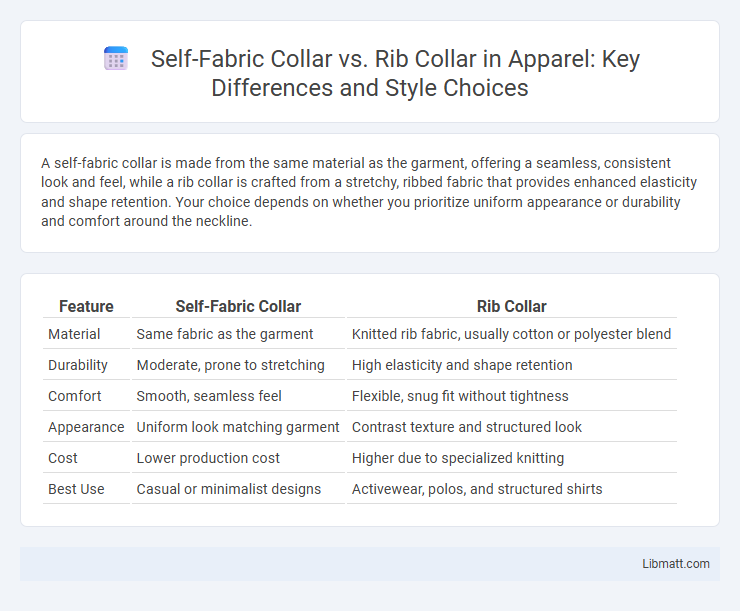A self-fabric collar is made from the same material as the garment, offering a seamless, consistent look and feel, while a rib collar is crafted from a stretchy, ribbed fabric that provides enhanced elasticity and shape retention. Your choice depends on whether you prioritize uniform appearance or durability and comfort around the neckline.
Table of Comparison
| Feature | Self-Fabric Collar | Rib Collar |
|---|---|---|
| Material | Same fabric as the garment | Knitted rib fabric, usually cotton or polyester blend |
| Durability | Moderate, prone to stretching | High elasticity and shape retention |
| Comfort | Smooth, seamless feel | Flexible, snug fit without tightness |
| Appearance | Uniform look matching garment | Contrast texture and structured look |
| Cost | Lower production cost | Higher due to specialized knitting |
| Best Use | Casual or minimalist designs | Activewear, polos, and structured shirts |
Understanding Self-Fabric Collars
Self-fabric collars are made from the same material as the garment, offering a seamless and cohesive look that enhances fabric continuity and durability. This type of collar provides better breathability and comfort compared to rib collars, which are typically made from a stretchy knit fabric that can add extra bulk or stiffness. Understanding the benefits of self-fabric collars helps you choose garments that maintain a polished appearance while ensuring comfort and longevity.
What Is a Rib Collar?
A rib collar is a type of neckline made from ribbed knit fabric, designed to provide elasticity and a snug fit around your neck. Unlike a self-fabric collar, which uses the same material as the main garment for a uniform look, the rib collar offers enhanced stretch and durability, making it ideal for activewear and casual shirts. Rib collars resist deformation and maintain shape through frequent wear and washing, ensuring lasting comfort and style.
Key Material Differences
Self-fabric collars use the same material as the garment, offering a seamless, uniform look and consistent texture, while rib collars are made from a distinct ribbed knit fabric designed for elasticity and durability. Rib collars provide greater stretch and recovery, making them ideal for activewear and casual styles that require frequent wear and flexibility. Your choice between self-fabric and rib collars will depend on the desired fit, comfort, and aesthetic finish of the garment.
Durability Comparison: Self-Fabric vs Rib Collar
Self-fabric collars, made from the same material as the garment, generally offer superior durability due to consistent fabric strength and reduced wear from washing or stretching. Rib collars, while flexible and comfortable, tend to lose shape quicker because their knit structure is more prone to stretching and fabric fatigue over time. For garments requiring long-lasting collar integrity, choosing a self-fabric collar can better maintain your clothing's appearance and fit during repeated use.
Comfort and Fit Considerations
Self-fabric collars, made from the same material as the garment, offer a seamless, flexible fit that enhances comfort by conforming naturally to your neck. Rib collars, constructed with a ribbed knit, provide greater stretch and durability, maintaining shape even after repeated wear and washing. Choosing between them depends on whether you prioritize the soft, integrated feel of self-fabric or the snug, resilient support of rib collars for your clothing.
Style and Aesthetic Appeal
Self-fabric collars offer a sleek, seamless look by using the same material as the garment, enhancing a cohesive and minimalist style ideal for modern and high-fashion pieces. Rib collars provide a textured, sporty aesthetic with their stretchable, knit construction, adding a casual and relaxed vibe often seen in athleisure and streetwear. The choice between self-fabric and rib collars significantly influences the overall visual impact and perceived formality of the clothing item.
Common Apparel Uses for Each Collar
Self-fabric collars are commonly used in high-end shirts and blouses to provide a seamless, tailored look that matches the garment's main fabric, enhancing the overall style and elegance. Rib collars are predominantly found in casual apparel such as sweatshirts, hoodies, and polo shirts, offering flexibility, durability, and comfort due to their stretchable knit structure. Each collar type is selected based on the desired aesthetic and functional properties, with self-fabric collars favoring formal wear and rib collars suiting active or everyday clothing.
Care and Maintenance Needs
Self-fabric collars require gentle washing to maintain their shape and elasticity, as harsh detergents can cause fabric distortion and color fading. Rib collars are typically more durable, allowing for frequent machine washing without significant loss of structure or stretch, but they may need occasional reshaping when damp. Both collar types benefit from air drying and avoiding high heat to extend longevity and preserve material integrity.
Cost Implications and Pricing
Self-fabric collars generally result in higher production costs due to the additional fabric required and complex sewing processes, making them more expensive than rib collars. Rib collars, crafted from stretchable knit materials, are cost-effective and simplify manufacturing, offering a budget-friendly option without compromising comfort or durability. Choosing between self-fabric and rib collars impacts pricing strategies, with self-fabric collars positioning garments at a premium price point while rib collars appeal to cost-conscious consumers.
How to Choose the Right Collar for Your Garment
Selecting the right collar for your garment depends on fabric weight, design style, and intended comfort. Self-fabric collars, made from the same fabric as the garment, provide a seamless, polished look ideal for formal shirts and structured pieces, while rib collars, crafted from knitted ribbed fabric, offer superior stretch and durability, making them perfect for casual wear like sweatshirts and polos. Consider the garment's purpose and desired flexibility to choose between the crisp appearance of a self-fabric collar and the breathable, resilient nature of a rib collar.
self-fabric collar vs rib collar Infographic

 libmatt.com
libmatt.com